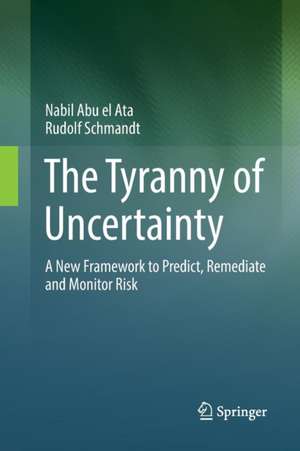The Tyranny of Uncertainty: A New Framework to Predict, Remediate and Monitor Risk
Autor Nabil Abu el Ata, Rudolf Schmandten Limba Engleză Paperback – 27 mai 2018
The authors offer a revolutionary solution to risk management. It’s the unknown risks that keep leaders awake at night—wondering how to prepare for and steer their organization clear from that which they cannot predict. Businesses, governments and regulatory bodies dedicate endless amounts of time and resources to the task of risk management, but every leader knows that the biggest threats will come from some new chain of events or unexpected surprises—none of which will be predicted using conventional wisdom or current risk management technologies and so management will be caught completely off guard when the next crisis hits. By adopting a scientific approach to risk management, we can escape the limited and historical view of experience and statistical based risk management models to expose dynamic complexity risks and prepare for new and never experienced events.
| Toate formatele și edițiile | Preț | Express |
|---|---|---|
| Paperback (1) | 394.12 lei 6-8 săpt. | |
| Springer Berlin, Heidelberg – 27 mai 2018 | 394.12 lei 6-8 săpt. | |
| Hardback (1) | 401.61 lei 6-8 săpt. | |
| Springer Berlin, Heidelberg – 24 mai 2016 | 401.61 lei 6-8 săpt. |
Preț: 394.12 lei
Nou
Puncte Express: 591
Preț estimativ în valută:
75.42€ • 81.90$ • 63.36£
75.42€ • 81.90$ • 63.36£
Carte tipărită la comandă
Livrare economică 22 aprilie-06 mai
Preluare comenzi: 021 569.72.76
Specificații
ISBN-13: 9783662569788
ISBN-10: 3662569787
Ilustrații: XXIV, 373 p. 116 illus.
Dimensiuni: 155 x 235 mm
Greutate: 0.56 kg
Ediția:Softcover reprint of the original 1st ed. 2016
Editura: Springer Berlin, Heidelberg
Colecția Springer
Locul publicării:Berlin, Heidelberg, Germany
ISBN-10: 3662569787
Ilustrații: XXIV, 373 p. 116 illus.
Dimensiuni: 155 x 235 mm
Greutate: 0.56 kg
Ediția:Softcover reprint of the original 1st ed. 2016
Editura: Springer Berlin, Heidelberg
Colecția Springer
Locul publicării:Berlin, Heidelberg, Germany
Cuprins
Framing the Risk Challenge.- Understanding the Hidden Risk of Dynamic Complexity.- Understanding the Nature of Risk.- Human Interaction and Perception of Risk.- Risk Evolves as Experience Evolves.- Why the Risk Comes as a Surprise.- Systemic and Systematic Risk.- How Risk is Currently Mitigated vs. How it Should be Mitigated.- Consequentialism is Necessary.- Uncertainty is the Enemy of Risk Management.- Modern Risk Management.- Evolution and Risk: The Bridge and the Missing Link.- Scientific Deterministic Risk Management.- The Role of Dynamic Complexity in Risk Propagation.- New Universal Risk Management Methodology (X-Act® OBC Platform).- Risk Discovery: Using Patterns to Spot the Unspottable.- Predictive Modeling.- Causal Deconstruction.- The Need for Hierarchic Predictive Emulation.- A Mathematical Treatise of Dynamic Complexity.- Emulative Deconstruction for Mathematical Prediction.- Singularity and Chaos Theory.- The Mathematical Solution.- Universal Risk Management Cases.- TheBig Dig: Business Evolution and IT Dephasing Creates Dynamic Complexity.- From Corporate Survival to Revival.- An Industry Reinvented by Design: Postal Services.- Expanding Under Control and the Transformative Evolution.- Healthcare System Efficiency: Avoiding a Major Misdiagnosis.- The 2007 Financial Meltdown: Was it Avoidable?.- Greece in Crisis: The Haze, Mirage and Survival.- Dealing with the Growing Epidemic of Chronic Crisis.- Risk Management: A Future Perspective.- Disruption: The Way to Fight Chronic Risk.- Epilog.
Recenzii
“The book offers a detailed and thorough analysis of risk, and a new approach to analyze and approach the mitigation of risks. The techniques described are well worth considering by large organizations utilizing complex systems that evolve over time to adapt to changing conditions.” (G. R. Mayforth, Computing Reviews, February, 2017)
Notă biografică
Nabil Abu el Ata, as the CEO and founder of Accretive Technologies, he has invested over 20 years maturing the science of risk management and the practical application of the company’s solution offering, X-Act OBC Platform, with over 15 patents. He offers a breadth of analytical skills, risk management and business intelligence expertise, as well as IT and business process management knowledge. In the late 1970s Dr. Abu el Ata's mathematical discoveries provided accurate coordinates for space exploration. By solving a problem that was previously defined as unsolvable, Dr. Abu el Ata set the foundation for a new era of risk management, which today enables companies to more accurately predict future system behaviors and take strategic actions to improve business outcomes.
Rudolf Schmandt has implemented risk management systems for major German banks and is widely applauded for his abilities to trouble-shoot high-end Unix systems. Major career milestones include successful execution of a 47 country EMEA IT consolidation and reorganization, which resulted in a much less complex footprint and lower costs, as well as, 10 years of success managing one of the biggest outsourcing deals worldwide. In his current position as Head of EMEA and Retail production for Deutsche Bank and Postbank Systems board member, he maintains responsibilities for production within EMEA. His aspirations include the development and design of the next generation of IT operations for the region, which serves 60,000+ users with E2E services.
Rudolf Schmandt has implemented risk management systems for major German banks and is widely applauded for his abilities to trouble-shoot high-end Unix systems. Major career milestones include successful execution of a 47 country EMEA IT consolidation and reorganization, which resulted in a much less complex footprint and lower costs, as well as, 10 years of success managing one of the biggest outsourcing deals worldwide. In his current position as Head of EMEA and Retail production for Deutsche Bank and Postbank Systems board member, he maintains responsibilities for production within EMEA. His aspirations include the development and design of the next generation of IT operations for the region, which serves 60,000+ users with E2E services.
Textul de pe ultima copertă
The authors offer a revolutionary solution to risk management. It’s the unknown risks that keep leaders awake at night—wondering how to prepare for and steer their organization clear from that which they cannot predict. Businesses, governments and regulatory bodies dedicate endless amounts of time and resources to the task of risk management, but every leader knows that the biggest threats will come from some new chain of events or unexpected surprises—none of which will be predicted using conventional wisdom or current risk management technologies and so management will be caught completely off guard when the next crisis hits. By adopting a scientific approach to risk management, we can escape the limited and historical view of experience and statistical based risk management models to expose dynamic complexity risks and prepare for new and never experienced events.
Caracteristici
Explains why risk plans based on experience and statistical models often miss major sources of risk, in areas as diverse as information technology, business, government, environment, healthcare, and economy Provides a blueprint of how to use mathematical emulation to expose and monitor unexpected sources of risk Includes risk management use case examples for IT reengineering projects, business transformation projects, competitive strategy, supply chain management, healthcare, and economy

















